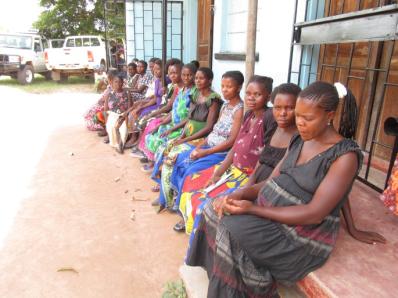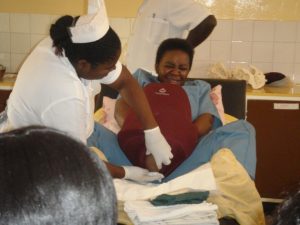Improving Emergency Obstetric and Neonatal Care in Zambia through Pre-Service Training

By Maura Christopher, American College of Nurse-Midwives
Imagine being a novice midwife in rural Zambia. You’re working in a peripheral health center in a remote area where you are the only health worker. You are totally alone except for a cleaner and a guard. You regularly confront emergency obstetric and newborn care cases where there is no time for referral. You must act in the moment alone and do the best you can under sometimes dire circumstances.
“Some emergencies cannot be referred without causing maternal and newborn mortality and morbidity,” says Patrice White, CNM, DrPH, interim director of the Department for Global Outreach for American College of Nurse-Midwives (ACNM). “For example, if a midwife doesn’t know how to recognize and competently manage postpartum hemorrhage—the leading cause of maternal mortality worldwide—a newborn with asphyxia, or a woman with eclampsia, the woman or baby may die.”

Patients waiting outside an antenatal clinic in Zambia. Courtesy of American College of Nurse-Midwives
Ten years ago, committed to addressing its maternal and newborn mortality and morbidity rates, Zambia’s Ministry of Health conducted an emergency obstetric and newborn care assessment. Then, as now, Zambian midwives and nurses provide approximately 87% percent of prenatal care and assist with 41% of deliveries (as compared with 4.5% of deliveries assisted by doctors or clinical officers).
Among the assessment’s conclusions was a recommendation to emphasize building the skills of health providers in emergency obstetric and newborn care, with a priority placed on strengthening pre-service midwifery training to prepare them for their real-world role. ACNM stepped up to help achieve this goal. A Frontline Health Workers Coalition partner, ACNM is the professional association of midwives that sets the standard for excellence in midwifery education and practice in the United States and has worked globally to strengthen the capacity of midwives in developing countries for more than 30 years.
Beginning in 2010, ACNM and its partner and subcontractor, the USAID-funded Zambia Integrated Systems Strengthening Program (ZISSP) and its follow-on project, Systems for Better Health (SBH) have worked with the Zambian Ministry of Health and the country’s General Nursing Council to strengthen clinical simulation, a teaching method that depicts real-life situations for students to address, in the skills lab. ZISSP and SBH partnered with ACNM staff who trained midwifery tutors and clinical instructors at 13 of country’s 18 midwifery schools. Guided by ACNM, the tutors and clinical instructors created a variety of simulation scenarios and learned to run the skills labs.
Additionally, the projects, with the help of ACNM, equipped each school with four to ten simulation stations. In the skills lab, students can practice various scenarios repeatedly before they go into clinical situations. They focus first on the management of normal birth, and then on infant resuscitation, postpartum hemorrhage, and other conditions such as breech delivery and shoulder dystocia, which seriously impact maternal and newborn mortality and morbidity. “We’re teaching students how to handle complications and how to handle them, if needed, alone,” White stresses.

A clinical instructor (in white) and a tutor simulate a normal delivery using the Mama Natalie model in Zambia. Courtesy of American College of Nurse-Midwives.
This process optimizes students’ time in the hospital. First, they learn the clinical skills more quickly because they’ve practiced them in the simulation lab. This leads staff members at clinical sites to permit the students to perform procedures on clients sooner, which builds the students’ confidence and skills.
Additionally, as their confidence grows, their patient interaction improves, which increases their diagnostic ability. “We’ve had feedback from the doctors and staff in the clinical areas, asking, ‘where did you find these students; they are so good.’” White adds. “Additionally, educators tell us the students themselves, all alone in their first posting, say they feel strong in their skills and more prepared.” Anecdotally, the improved training is having a genuine impact. Though it’s difficult to accurately measure infant and maternal mortality and morbidity and almost impossible to assign causality, what’s clear is, in Zambia, infant and maternal mortality and morbidity is decreasing--one confidently handled birth at a time.
